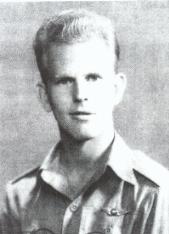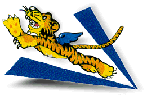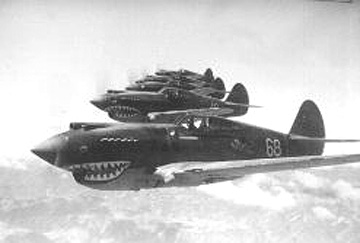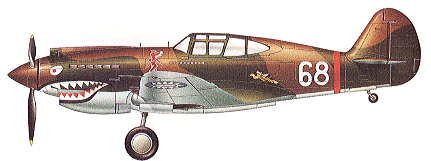
Amazon Audible Gift Memberships



There are many people today who don't know who the Flying Tigers were. Many erroneously think that anyone who served in China during the war was a Flying Tiger.
Seven months before Pearl Harbor, less than 300 personnel from the military volunteered for an undercover mission in China. Their assignment was to help the Chinese defend their cities and the Burma Road. Except for the old "Marco Polo Silk Route over the "Roof of the World," that took a Camel Caravan almost one year to traverse, the Burma Road was China's only remaining supply route. Even this route had been closed by the British because of Japanese pressure, but was reopened at the insistence of the United States.
The original plan included three groups of volunteers. There were to be two fighter groups and one bomber group. The first group flying Curtiss P-40s, the next fighter group would have Seversky P-43s, and the third, a bombardment group, were to fly bombers made by Lockheed. The first group to arrive in Burma was of course dubbed "The First American Volunteer Group." However, Japan's attack on Pearl Harbor forced the cancellation of the second two groups.
Since the American Volunteer Group was an undercover military operation, no civilians were considered. Military pilots, and ground personnel had to be on active duty to be acceptable. Every man in the American Volunteer Group, as the name implies, was a volunteer.
The original intent was to recruit only pilots who had flown the Curtiss P-40. Finding it impossible to get the necessary number of experienced P-40 pilots, the initial requirements for fighter pilots were dropped. The final make-up of the AVG was a third from each service, the Army, Navy, and Marines, regardless of types of planes they had flown.
A state of emergency had been declared in early 1940, which prevented anyone from leaving the armed forces. To get around this, an executive order was signed by President Roosevelt in May 1940, allowing men in the armed forces to resign from the military, specifically for this undercover mission in China.
After being accepted for this secret mission, as a cover,
the men were required to:
1. Resign from the military.
2. Sign a contract with a company operating in China by the
name of Central Aircraft Manufacturing Company.
3. Voluntarily join the Chinese Air Force upon arriving in the
Far East.
According to Chennault joining the Chinese Air Force would
give the volunteers belligerency status. Meaning that if anyone of
the volunteers happened to be captured by the Japanese, he would be
treated as soldiers, not as civilians. As a civilian, he could be
tried for murder if it was proven he had killed a Japanese
national.
Although the Japanese were not signatories to the Geneva convention, it was hoped that if any of us was captured, we would be treated as a prisoner of war rather than tried in a criminal court.
On December 7, 1941, the day the Japanese attacked Pearl Harbor, the American Volunteer Group had approximately 260 men, 82 of whom were pilots, two of these men refused combat, and were assigned to ground jobs.
I think credit for the name "Flying Tigers" was first used by a United Press Correspondent by the name of McGrath, whose news report was datelined, Rangoon December 26, 1941, and referred to our group as "Flying Tigers," should get the credit for being the first to use it. The name "Flying Tiger" eventually became synonymous with AVG and later replaced the name AVG. There are others who may disagree with my contention, but I have copies of the original newspaper clipping.
Chennault's small group of volunteers destroyed 297 Japanese aircraft, which were confirmed by British and Chinese Intelligence and accomplished within a seven-month period.
Incredulously, verbal reports by the Japanese pilots claimed they shot down 544 AVG planes. Perhaps this is why their large losses were acceptable to them.
As a result of Japan's sneak attack on Pearl Harbor, the United States lost most of its fleet. Our troops on Guam and Wake had surrendered. The Philippines succumbed to a ruthless enemy. Ten-thousand American POW's died during the Bataan death march, as a result of the inhumane treatment they received.
The British had lost Singapore, and Hong Kong. The Japanese navy had sunk Britons battleships Repulse, and Prince of Wales off the Malayan Peninsular.
American's Flying Tigers were shooting Japan's war planes out of the sky in large numbers. Even though the Flying Tigers were greatly outnumbered at times as much as twenty to one, we were able to inflict massive casualties on Japan's Air Force at an incredible rate of more than 50 Japanese killed for each American lost.
During this somber period in our history, the only success the allies were having was with this small group of Americans fighting under Claire Lee Chennault.
To accomplish this, the Flying Tigers lost 4 pilots in aerial combat, seven killed by ground fire as a result of strafing missions, three became prisoners of war, 11 were killed in accidents unrelated to enemy action, 3 men succumbed to injuries suffered as a result of Japanese bombing raids, and one missing in action presumed dead.
Even today Daniel Ford still claims that the AVG Flying Tigers was a mercenary group and refuses to believe we were actually on an undercover mission. Therefore the cover for this mission must have been quite convincing.

Why were we so effective?
First, we had all graduated from American Military Flying Schools, I feel was the best in the world, where students that didn't meet the strict standards of pre-war military pilots were eliminated. Second, the knowledge Chennault imparted to pilots of the American Volunteer Group contained detailed information on all the Japanese aircraft including performance, type of aircraft, size of armament, strength and weakness of the Japanese planes and crew. He pointed out the vulnerable spots from which to attack, and their blind spots, type of attacks to make, and those to avoid, strong points of the P-40 and its weaknesses.
The third reason for our overwhelming success is overlooked. We only attacked when we had the advantage over the Japanese, avoided combat if we didn't. Chennault was an advocate of hit and run tactics, that some commanders considered acts of cowardice. Even though Erich Hartman, Germany's leading Ace had 352 confirmed victories and used this same tactic exclusively. We were on the defensive, our only objective was to shoot down as many enemy bombers as possible with the smallest possible loss to ourselves.
The Japanese fighter's job was to defend their bombers. They couldn't run even when in difficulty. Leaving the bombers defenseless would have been considered cowardice on their part, and their pilots would probably be shot for such action. Our primary job was to destroy the bombers in their attempt to destroy ground installations. However, if we were in trouble, we were free to leave the area having sufficient speed to escape, they didn't. We would return to the fracas only when we had the advantage. Japanese fighter pilots didn't have the luxury of such tactics.
The fourth reason was that all of Japan's aircraft, including the much vaunted Zero, were inferior in every respect to ours with one exception: the ability to turn in a small circle. However this was of little military value, if the pilot avoided the so called dogfight, or turning combat, but used hit, and run tactics which Chennault had taught us in the AVG.
More gunnery practice could have made every one of our pilots one hell of a lot better in destroying the enemy. Pilots with insufficient gunnery skill exposed themselves to more danger than a marksman, because it required many more passes at a bomber formation to get results. The best pilot in the world cannot have the success of an average pilot if the average pilot is an excellent marksman.
Lack of replacement parts for the aircraft, and poor radio equipment, which were identical to an off the shelf item that could be purchased at any Piper Cub dealer in the states.
Attitudes were mixed among the AVG. We thought that it was good riddance for one, and the other was anger. They had signed up to do a job, and with their leaving, made our jobs more dangerous.
Heat, humidity, myriads of insects could be hard to bear. There wasn't much to be said about our living conditions that would be considered enjoyable, especially the frequent bouts of dysentery. I was able to overlook all of these since I had a voracious appetite for excitement and adventure. There were many enjoyable experiences afforded me that otherwise I would never have been able to have seen. There were many men that were able to laugh at their discomfort. I would be willing to relive that period in my life over again.
Mail from home, close friends and family left behind, although I later considered many in the AVG to be family. Ice- cream, fresh vegetables, milk and decent meat. Water Buffalo was the only meat available and extremely tough, slaughtered only after the end of its useful life, and too old to plow the fields or pull carts. One thing I wish I had brought with me was a good camera and lots of color film.
When we were escorted by the cruisers North Hampton and Salt Lake, I felt that officially Washington cared, and wanted us to get there safely. Later, as the American military presence was increasing in China, I had the feeling that it was the War Department that didn't give a damn and would have preferred to see Chennault fail, even at the expense of losing American lives. The amount of supplies given to the AVG were no longer under the direction of the White House, but subject to the dictates of the War Department. Supplies were reluctantly released to us at Chiang's insistence, and only when Generalissimo Chiang Kai Shek threatened to surrender. Even then, supplies intended for us were often short stopped and released to other units, though they were not in a combat zone.
The Burma Road was the roughest and most dangerous damn road I have ever driven, but I enjoyed the adventure very much. The difficulties of driving the Burma Road can best be understood by describing some of the challenges facing those who drove the road. For example, the approach to the bridge over the Salween River was awesome to see from the top of the mountain that overlooked the salween gorge and the suspension bridge that spanned the river. A direct line distance of one mile, but a distance of 20 miles to get there by road. Airline distance from Lashio to Kunming was 330 miles, by the Burma Road it was over one thousand miles, and traveling by truck took the better part of a week.
The Chinese army, that had been under General Stillwell's command, was in disorganized retreat, going back to China. Stillwell had abandoned his command, and left the Chinese army to fend for themselves.
"Vinegar Joe" Stillwell was retreating in the opposite direction on his way to India. The only thing that stood between China and Japan's Red Dragon Division was Chennault's Flying Tigers. Had the Japanese army been successful in crossing the Salween river, it was most likely that the entire country of China would have fallen.
Although the allied world was crumbling, the unparalleled success of the Flying Tigers over the Japanese was an answer to fervent prayers of the free world. This taste of victory against Japan was a light at the end of a long dark tunnel, and a ray of hope in face of the disasters befalling the allies throughout the rest of the world. Our successes against unbelievable odds, left no doubt in the minds of the American people as to the eventual outcome of the war. Oddly enough we were flying a fighter plane the British didn't want, and by U.S. Army Air Corps standards, was considered obsolete, yet we were making aviation history with the Curtiss P-40.
From a military standpoint, the most important, but seldom referred to, and overlooked concerning its importance to the war effort, was that the Flying Tigers alone stopped the rapidly advancing crack Japanese army, known as, "The Red Dragon" at the Salween River Gorge.
If the revisionist have their way as they re-write history, we will not be looked upon kindly. It appears that the prestigious Smithsonian Museum is just the start of what appears to be the start of a revisionist's movement. This includes the Smithsonian's original intent to display the Enola Gay, the aircraft that dropped the first Atomic bomb, showing the horrors of the bomb without mentioning that it shorted the war considerably, and very likely saved more than a million Japanese and American lives. Many Japanese still will not accept the truth of their debacle, instead blame the Americans for causing the war. Some of the younger Japanese say we forced their hand making them attack first.
The subtle propaganda has already started. The spiel given by the guides in Hawaii, to those visiting the USS Arizona War Memorial, hear that Pearl Harbor was possibly the fault of the Americans. This is because quite a number of visitors to the memorial are Japanese tourists, and we are afraid they will be offended.
Some revisionists see the Japanese as harbingers of peace, since their peace envoys were in Washington at the time. They feel we should have continued the peace talks, and that our Far East policy goaded them into attacking Pearl Harbor. Japan called their take-over of all of Asia as the "Greater East Asia Co- prosperity Sphere." Forgotten is Japan's often repeated slogan, "Asia for Asians," when in actuality it was, "Asia for the Japanese."
Almost total lack of support by the American military. The AVG flying aircraft in combat that training schools in the states would have grounded as being unsafe for flight. The same feeling that the Viet Nam Vets had of being forgotten by the American people back home. The difference being that we were looked upon by the American people as heroes, but despised by many high ranking military men.
I believe it is the Christmas day battle over Rangoon, that caught the imagination of the entire free world, especially the United States. It lifted our own morale in the face of pronouncements by such notable war correspondents as Leland Stowe and others, claiming once war started the AVG would be lucky to survive two weeks.
American Newspaper headlines, on December 26, 1941, read FLYING TIGERS SHOOT DOWN 30 ENEMY PLANES. Sub headline, "American Volunteer Group downs 23 Japanese planes over Rangoon Without Loss!" By Robert L. McGrath, Special Features correspondent. (Note the discrepancy in the headline and the sub-headline). (AVG claimed 24 Japanese aircraft shot down, but British intelligence could only confirm 17. Therefore the official count credited to the AVG was 17.)
The origin of the name Flying Tigers, seems to have faded into obscurity, and there are many versions told by the Tigers themselves, explaining its origin. For what it's worth, through research I have come up with the following: Included in a news release date line Rangoon, Burma, Dec. 25, 1941 by Robert McGrath - Quote, "In a Rangoon pub after the battles had subsided, a news correspondent remarked that "That the Americans flew like tigers up there," a lady reporter for LIFE magazine responded with, "Yeah-Flying Tigers!" the name certainly seemed appropriate, given the results of their December 25 skirmishes." Unquote.
Possibly Loiwing, when quite a few new P-40E on their way to Kunming to be delivered to the AVG, caught on the ground and burned. Or the potential disaster by insistence of General Stillwell trying to use us to pull his chestnuts out of the fire. He ordered Chennault to have the AVG patrol over the Chinese front line in Burma. We were told that we had to fly low enough for Chinese to recognize our airplanes as friendly aircraft. In the opinion of many, it could have been a disastrous mission that most all AVG refused to fly. It was later flown by volunteers, but actually a revised mission. Some referred to this as the Loiwing revolt. I would also put on this list that General Chennault, although deserving to be aboard the Battleship Missouri during the surrender of Japan, wasn't invited. The only mention of his absence was by General MacArthur when he asked, "Where's Chennault?" The Old Man had been relieved of his command a few short weeks before the end of the war.
Yes, in a moment, but with two minor revisions. I would have made an attempt to participate in more aerial combat. I feel that I was better than any Japanese pilot. On the other hand, I never desired to participate in ground strafing. If I had my choice, I would have wanted to limit the attacks to two strafing runs at the most. Any more than that, with the element of surprise gone, chances of survival diminished drastically. The other would have been more gunnery practice and less formation flying, except for rudimentary formation practice, since I feel it was a waste of valuable flight time. I enjoyed the flight training the most.
Only slightly. They do not appear as fanatical, but have become more cunning. They would be more difficult for us to prevail against in another war.
Lack of desirable food or lodging could be overlooked. Therefore it had to be our lack of spare parts. The lack of adequate warning in many cases.
We had a leader that we liked and trusted. American military pilots were superior to, and better trained than the Japanese and we knew it. Our equipment was superior to Japan's. Their airplane design sacrificed pilot protection for lightness of construction, and the antiquated tactic of the turning combat in mind. The zero had earned an undeserved reputation before our involvement in the war. The Japanese thought the airplane was so outstanding, it remained virtually unchanged throughout the war. Human life in the Orient was cheap, therefore their pilots were expendable. The Zero lacked armor plate and self sealing fuel tanks which our aircraft had and a factor that saved many of our pilots.
Our planes were designed with pilot protection uppermost, which included ruggedness and ability to withstand great punishment and still bring the pilot back. Next was speed in both dive, straight and level, and roll rate. Without these combinations Chennault's superb leadership and tactical know how would have been frustrated. Last reason we survived was because we were non-military.
I have read many books written by pilots and crews in military outfits, that seemed to have an underlying dislike, distrust and at times down right hatred for some men in their squadron. This was not so in the AVG, Chennault eliminated the undesirable, which couldn't be done in the military. I have read some books claiming the Jews were discriminated against. I had Jews both in the flight school and in the AVG. None were discriminated against to my knowledge, actually the opposite was true in the AVG. Most had a great sense of humor, and were able to defuse tense moments during times of hardships.
Lacy Mangleburg's death hit me the hardest. For a time I had given some thought of returning home.

Thoughts on the attributes of the P-40:
A different approach may convince some of the readers the reason why our successes against the Japanese was so outstanding. After reading the following, don't feel sorry for Japanese, they started the damn war.All of the aircraft listed below are contemporaries of the P-40. As an added comment and question, why do many insist upon comparing apples and oranges. Surely there can be no doubt in anyone's mind that the F8F was superior to its forerunners, but it wasn't flying in combat in December of 1941. Why compare it to earlier fighters? Makes as much ense as comparing the F-16 with Germany's Fokker triplane.
The P-40's contemporary fighter aircraft, were the Japanese A6M2 21, and the Hayabusa Ki-43. Germany's Messerschmidt the Me. 109 E-3, Briton's Spitfire Mark I as well as the Hurricane.
End of part one.
